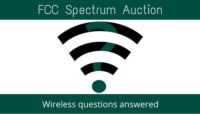by Brian Grahn, Sales/Marketing

As of January 18, 2017, the fourth stage of the FCC Incentive Auction has proceeded into the Forward Auction phase. In these confusing times, Shure has created their Incentive Auction Resource Center where they are compiling and updating information as each stage of the process is completed. The website provides great details about many of the nuances of the auction system, but we have included some of the basic information here for easy reference.
What is the Incentive Auction?
Congress has directed the FCC to reallocate some of the UHF TV Spectrum for use by broadband wireless devices, such as smart phones. Unlike the 700 MHz auction, the incentive auction offers broadcasters an opportunity to voluntarily give up spectrum in return for a share of the auction proceeds, hence the term “incentive auction”. This auction is sometimes referred to as the “600 MHz Auction” because the frequencies offered at auction start at 698 MHz (currently the top-end of the UHF TV band) and move down from there. After 4 stages, supply met demand with a reallocation of 84 MHz (614-698 MHz). TV stations electing to continue operations will be “re-packed” into channels below TV37. The UHF TV band is therefore getting smaller, and what remains will likely be more crowded.
How does the Auction work?
The Incentive Auction consists of several sequential phases: the reverse auction, forward auction, and spectrum re-pack. In the reverse auction phase, broadcasters that have elected to participate submit an exit price for relinquishing their spectrum assignment. The level of participation in this phase determines how much spectrum is available for auction and its corresponding valuation. These figures are also known as the clearing target and clearing cost. After the reverse auction, the buyers (such as, AT&T, Verizon, Comcast, Dish, T-Mobile, etc.) bid on the available spectrum during the forward auction. If the dollar amount generated during the forward auction is less than that of the reverse auction, the process repeats. This sequence of reverse and forward auctions is known as a “stage.” After 4 stages that began March 2016 and ran through Jan 2017, the dollar amount generated in the forward auction exceeded that of the reverse auction.
Since Stage 4 of the auction was successful, a new UHF band plan will be issued and work begins to repack the UHF TV spectrum. Once the band plan is made public, the clock starts on a 39-month transition. During this time, broadcasters will move to their new TV channel assignments, and the auction winners will begin building out their new services. Once a new service commences operation, wireless microphones that operate in the spectrum between 617 MHz through 652 MHz and 663 MHz through 698 MHz can no longer be used, making this a rolling transition on a city by city basis. However, the entire repacking process is scheduled to be completed by the end of this 39-month period, after which time no wireless microphones may legally operate in any of the auctioned spectrum, regardless of its level of occupancy. At this time, the soonest this could happen would be sometime in the year 2020.
How will the Auction affect my wireless systems?
The FCC has successfully auctioned 84 MHz of UHF spectrum. 70 MHz of this spectrum will be reallocated to mobile broadband services. A 3 MHz band and an 11 MHz band will be used as a guard band and a duplex gap band. During the 39-month transition period, if you own wireless microphone systems that operate in auctioned spectrum (617-652 MHz and 663-698 MHz), it will be your responsibility not to interfere with new services once they begin operation. At the conclusion of the transition period, operation of wireless microphones in the auction spectrum will not be permitted by law. On a practical level, it is likely that these new services will create an unpredictable spectrum environment, resulting in interference that will impact the reliability of a wireless microphone operating in this spectrum. Equipment owners are advised to confirm the operating frequency range of their systems and comply with the new rules of operation during and after the transition period. It is worth noting that 653 MHz through 663 MHz will still be available for wireless microphone operation, with some restrictions, during and after the transition period. See our webinar (linked below) on the topic for more details.
For more information about the auction, visit the Shure Incentive Auction Resource Center.
If you have any additional questions about how the auction could potentially effect your current wireless systems and help planning for the future, contact our Sales Team at 847.367.9588 or sales@tcfurlong.com.